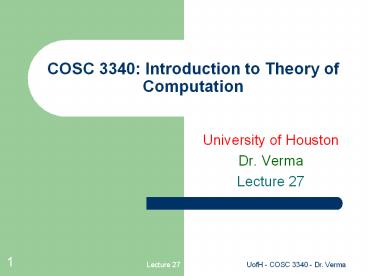COSC 3340: Introduction to Theory of Computation - PowerPoint PPT Presentation
Title:
COSC 3340: Introduction to Theory of Computation
Description:
COSC 3340: Introduction to Theory of Computation University of Houston Dr. Verma Lecture 27 Diagonalization Principle Let S be any nonempty set and R any relation on S. – PowerPoint PPT presentation
Number of Views:76
Avg rating:3.0/5.0
Title: COSC 3340: Introduction to Theory of Computation
1
COSC 3340 Introduction to Theory of Computation
- University of Houston
- Dr. Verma
- Lecture 27
2
Diagonalization Principle
- Let S be any nonempty set and R any relation on
S. - The principle states that
- the complement of the diagonal is different from
each row. - Can be generalized to relations on two sets,
etc. - Example
- Let S a, b, c, d.
- R (a, a), (b, c), (b, d), (c, a), (c, c), (c,
d), (d, a), (d, b)
3
Example (contd.)
- R (a, a), (b, c), (b, d), (c, a), (c, c), (c,
d), (d, a), (d, b)
a b c d
a
b
c
d
a b c d
a X
b X X
c X X X
d X X
X
X
complement of the diagonal
4
Applications of Diagonalization.
- The principle is very useful to show that
enumerations of some sets cannot be exhaustive. - For example, one can show
- 2N is uncountable.
- The set of real numbers in the interval 0,1 is
uncountable. (Exercise) - The set ltM, wgt M accepts w is not Turing
decidable.
5
2N is Uncountable.
- Suppose that it is countably infinite. Then there
is an enumeration 2N S0, S1, S2, ... using
the bijection between N and 2N . - Let D i ? N i ? Si.
- D is a subset of N so it belongs to 2N .
- So, D Sk for some k ? N.
6
2N is Uncountable (contd.)
- We ask whether k ? Sk.
- Case 1. k ? Sk. By definition of D, k ? D, but D
Sk, so contradiction. - Case 2. k ? Sk. By definition of D, k ? D, but D
Sk, again contradiction. - Hence our hypothesis that 2N is countable is
false (q.e.d.).
7
Where was Diagonalization used?
- Consider N X S0, S1, .....
- D is the complement of the diagonal of this
infinite relation.
0 1 2 3 . .
s0 X X
s1 X X
s2
s3 X X
. X
.
8
Proof for ATM ltM, wgt M accepts w
- Suppose that H is a decider for ATM.
- On input ltM, wgt, H halts and accepts if M accepts
w and H halts and rejects if M rejects w. - H(ltM, wgt) accept if M accepts w
- reject if M does not accept w.
- Now we construct a new Turing machine D with H as
a subroutine. D calls H to determine what M does
when input to M is its own description ltMgt.
9
Proof for ATM (contd.)
- D On input ltMgt, where M is a TM
- Run H on input ltM, ltMgtgt.
- Output the opposite of what H outputs that is,
if H accepts, reject and if H rejects, accept. - D(ltMgt) accept if M does not accept ltMgt
- reject if M accepts ltMgt.
- What happens when we run D with its own
description ltDgt as input? In that case we get - D(ltDgt) accept if D does not accept ltDgt
- reject if D accepts ltDgt.
10
Proof for ATM (contd.)
- Basically,
- Assume that a TM H decides ATM.
- Then use H to build a TM D that when given input
lt M gt accepts exactly when M does not accept
input lt M gt. - Finally, run D on itself.
- The machine take the following actions, with the
last line being the contradiction. - H accepts ltM, wgt exactly when M accepts w.
- D rejects lt M gt exactly when M accepts lt M gt.
- D rejects lt D gt exactly when D accepts lt D gt.
11
Proof for ATM (contd.)
- Examine tables of behavior for TMs H and D.
lt M1 gt lt M2 gt lt M3 gt lt M4 gt . . .
M1 accept accept
M2 accept accept accept accept
M3 . . .
M4 accept
12
Another Perspective on Halting Problem
- If L is a Turing-decidable language then L
(complement of L) is also Turing-decidable. - If it were possible to predict for any TM M and
any input string whether or not M would halt on
that input, then every Turing-acceptable language
would also be Turing decidable.
13
Another Perspective
- K0 ?(M) ?(w) Turing machine M accepts input
string w. - If K0 is decidable then every Turing acceptable
language is also Turing decidable. - K0 is Turing acceptable.
- Every Turing acceptable language is Turing
decidable iff K0 is Turing decidable.
14
Another Perspective
- If K0 is decidable,
- K1 ?(M) TM M accepts input string ?(M)
would also be Turing decidable. - If K1 is decidable then so is complement of K1,
K1, is not even Turing acceptable - K1 w ? I, c w is not the encoding of any
TM M, or w ?(M) for some M that does not accept
its own encoding































